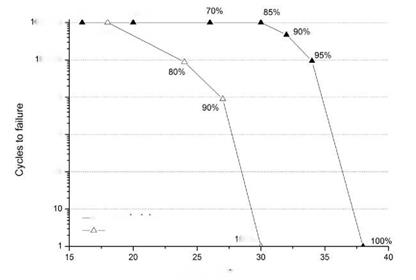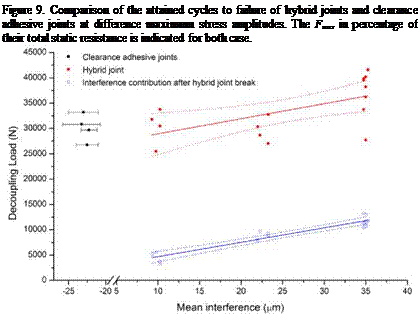A tension-tension fatigue test was performed on the hybrid joints bonded with the FT-EP at 35 цт of interference and the FT-EP bonded samples with clearance, in order to investigate the influence of the interference on the fatigue behavior of the joints.
The same load amplitude was employed both for the hybrid samples and the bonded-with-clearance ones. The static resistances used as reference for both the cases were calculated from the previous experiments (Gallio et al., 2014).
The results obtained for the hybrid joints were not comparable with the clearance adhesive samples in terms of absolute values of the amplitude load. In fact, the hybrid joints presented higher statical resistance (of about 7000 N) than the clearance ones, so they were expected to begin to suffer the effects of fatigue cycles at higher amplitudes. Nevertheless, it was possible to compare the two cases in terms of a percentage of their static resistance.
The comparison of the fatigue behavior of the hybrid and clearance joints is depicted in figure 9. It could be noted that the hybrid joints underwent the total amount of the fatigue cycles up to a amplitude of about 85 % of their static strength. For higher amplitudes, the samples did not pass the test, failing at about half million of cycles at a maximum amplitude of 90 % and at the beginning of the test for an amplitude amounting to 95 %. On the other hand, the adhesive joints in clearance condition failed around 105 cycles if stressed with a max amplitude equal to only 80 % of their static strength, and underwent the million cycles at 60 %. It seemed that the interference played a beneficial role on the fatigue behavior of the samples, as the hybrid joints managed to sustain 106 cycles at amplitudes equal to higher percentages of their static resistance with respect to the clearance joints. Both the systems were characterized by similar resonance frequencies of 198.5 ± 1.5 Hz.
|
|
|
|
|
|
|
|
|
|
|
|
|

![]()
a— Hybrid joint
![]() Clearance adhesive joint
Clearance adhesive joint

Max Amplitude (KN)
Figure 10. The pull-out loads of the hybrid joints, the interference contribution (detected by the load after break of the hybrid joints) and the adhesive joints in clearance condition as a function of the interference level.
 18 сентября, 2015
18 сентября, 2015  Pokraskin
Pokraskin  Опубликовано в рубрике
Опубликовано в рубрике 